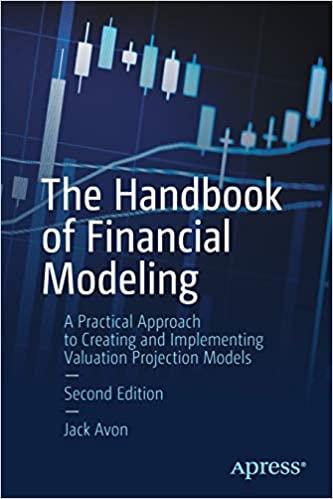Question
As a reminder, we covered in class re: the mechanics and implications of mortgage lending. Specifically, a scenario where an individual buys a house for
As a reminder, we covered in class re: the mechanics and implications of mortgage lending. Specifically, a scenario where an individual buys a house for $100,000, hold it for three years and sells it. Over that three year period, the owner must pay the bank interest, and there may be a tax implication. To keep things simple, the mortgage payment is interest only. ie, if you borrow 100,000, and interest is 10%, you end up paying 30k in interest, but have to pay back the full 100,000 loan and 30k in interest at the end of the 3 year loan. While this is an example around an individuals decision to purchase a house, we are using this as a way to understand a CFOs decision to capital investments. Put another way, you are the CFO of a household making a capital decision on how to fund your home investment. I will refer to this as the CFO of the household making a housing investment decision.
The table directly below is the base case for illustration. To explain in particular, the row in yellow. CFO of house buys house for 100k. Using 20k in equity, plus an 80k loan. Over the three year period, CFO of house pays 24k in interest (10% times 80k=8k per year, times three years), but at a 50% tax bracket, the net outlay is 12k. In this scenario, house increases to 140k in value over three years. Therefore the CFO of the houses return is 28k. 40 k on the increase in value of the house less the 12k interest payments. Since the CFO of the household put 20k down, the ROE is 140%.
Please answer the following questions by filling in the grids, and answering the questions. The information and answers within each grid should help with each question.
| House Value Year 1 (Purchase) | Money Put down by purchaser (Down Payment) | Bank Loan (Mortgage) | Net Interest Paid to Bank (10% loan 50% tax bracket) | House Value at point of sale (after 3 years) | Net Return on house investment (increase in house value payments to bank) | Return on Equity = Net Return / Money put down |
| $100,000 | $100,000 | 0 | 0 | $140,000 | $40,000 | 40%=40,000/100,000 |
| $100,000 | $50,000 | $50,000 | $7,5000 | $140,000 | $32,500 | 65%=32,500/50,000 |
What happens if the expected house value is not that big? Rather than growing to 140k, we know the house will only increase in value to 110k. What is the ROE under different financing options? And how would you recommend the CFO finance this deal?
| House Value Year 1 (Purchase) | Money Put down by purchaser (Down Payment) | Bank Loan (Mortgage) | Interest Paid to Bank (10% loan 50% tax bracket) | House Value at point of sale (after 3 years) | Net Return on house investment (increase in house value payments to bank) | Return on Equity = Net Return / Money put down |
| $100,000 | $100,000 | 0 | 0 | $110,000 |
|
|
| $100,000 | $50,000 | $50,000 | $7,5000 | $110,000 |
|
|
| $100,000 | $20,000 | $80,000 | $12,000 | $110,000 |
|
|
Step by Step Solution
There are 3 Steps involved in it
Step: 1

Get Instant Access to Expert-Tailored Solutions
See step-by-step solutions with expert insights and AI powered tools for academic success
Step: 2

Step: 3

Ace Your Homework with AI
Get the answers you need in no time with our AI-driven, step-by-step assistance
Get Started


